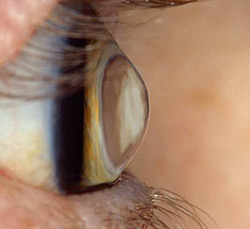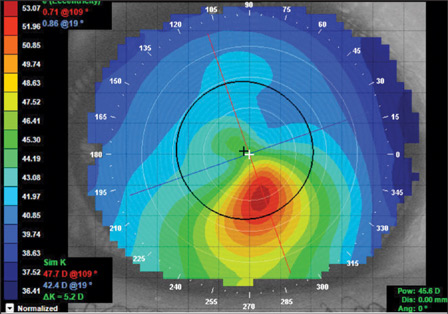Keratoconus
Keratoconus is a rare condition that affects the clear structure in the front of the eye, the cornea. Learn how we can help.
 As the condition progresses, the cornea becomes excessively steepened and thinned forming a cone-like bulge (technically termed ectasia). In advanced cases, scarring can occur leading to the necessity for corneal transplantation. Because the cornea acts as a lens, irregular curvature of the cornea leads to distorted optics and blurred vision that is sometimes not correctable by glasses. Simple visual tasks can become difficult, reducing quality of life.
As the condition progresses, the cornea becomes excessively steepened and thinned forming a cone-like bulge (technically termed ectasia). In advanced cases, scarring can occur leading to the necessity for corneal transplantation. Because the cornea acts as a lens, irregular curvature of the cornea leads to distorted optics and blurred vision that is sometimes not correctable by glasses. Simple visual tasks can become difficult, reducing quality of life.
The condition is usually bilateral (affecting both eyes), beginning in the teenage years, and tends to progress at different rates in each eye. Individuals affected by keratoconus can also advance at drastically different rates. Some have advancement for 10-20 years followed by long stages of stability, while others can advance rapidly to needing surgery.
Early symptoms of the condition include:
- blurred vision,
- increased light sensitivity,
- squinting,
- double vision out of one eye,
- ghost images,
- and halo-ing around light sources, along with mild ocular irritation.
As the condition progresses, vision can become increasingly more blurred even while wearing glasses or soft contact lenses.
Because keratoconus does not cause acute inflammation and redness, the condition can go undiagnosed for many years. Acute practitioners will pick up on subtle corneal structural changes, patient symptomology, and irregular reflex on retinoscopy in making the initial diagnosis. A definitive diagnosis is made with the use of corneal topography.
Causes of Keratoconus:
The exact cause of keratoconus is not known. Some of the more common theories on causation and correlation include:
- Frequent eye rubbing
- People suffering from atopic/allergic conditions
- Genetics (10% of individuals with keratoconus have a family member with the condition)
- Down’s syndrome
Keratoconus Treatment:
 Rigid gas permeable (RGP) contact lenses are the standard of care for keratoconus. Their rigid design allows for the lens to produce a new, regular, spherical refracting surface, improving the irregular optics of the eye and providing drastically improved vision. Dr. Garretson has extensive experience with many different RGP designs and can find the appropriate option that will work best for you!
Rigid gas permeable (RGP) contact lenses are the standard of care for keratoconus. Their rigid design allows for the lens to produce a new, regular, spherical refracting surface, improving the irregular optics of the eye and providing drastically improved vision. Dr. Garretson has extensive experience with many different RGP designs and can find the appropriate option that will work best for you!
Fitting patients with keratoconus properly requires not only a lot of experience but also a high level of skill and patience. Frequent visits for lens modifications are the rule, not the exception.
We will work together to find the most comfortable option for you that provides a level of visual acuity that meets your expectations.

